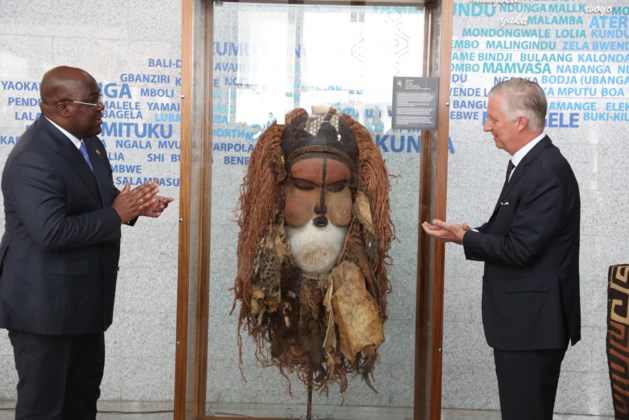When King Philippe visited the Democratic Republic of Congo in June 2022, he wanted to demonstrate that Belgium is ready to start a new chapter in relations between the two countries. And to do that, he handed over a precious carving known as the Kakuungu Mask on an indefinite loan. The mask is one of many cultural artifacts taken from Congo that Belgium has promised to return.
But that same month, an ethnic conflict broke out in Kwamouth, a district north of the capital Kinshasa, pitting the local Teke people against the Yaka and Suku. A conflict sparked by the returned mask. Because the Kakuungu mask is revered by both the Suku and the Yaka as an ancestral symbol of war. They believe it grants magical powers to the fighters, making them invulnerable to bullets and able to disappear.
(Read more below the photo)
Unveiling of the mask in Congo in 2022. — © BELGA
According to the United Nations group of experts, the return of the mask would therefore have encouraged the Suku and Yaka militias to carry out brutal attacks on Teke communities. At least 300 people have already been killed and another 160,000 have fled. There are no exact figures as the Congolese army has sealed off the hardest-hit area. Humanitarian groups cite unconfirmed figures of more than 3,000 deaths.
Deep roots
The conflict between the tribes has deep roots. It all started with a disagreement over land rights. The Yaka and the Suku paid taxes to the Teke chiefs for years. In exchange they were allowed to work the land. But in 2022, those chiefs tried to raise taxes, setting off the first clash between the tribes.
The conflict worsened and it appeared that the Mobondo, the name given to themselves by the Suku and Yaka militias, were attempting to drive the Teke out of Kwamouth and nearby areas.
“The lack of accountability for alleged perpetrators reinforces distrust among communities”
Thomas Fessy
Researcher at Human Rights Watch
The Congolese government decided to send a ‘pacification commission’ there in September 2022. But that just exacerbated the conflict, because the leader of the commission, Fabrice Kavabioko, turned out to be a high-ranking member of the Suku and also one of the figureheads of the Mobondo. Although Kavabioko is said to have said that he was “entrusted with the mission to restore peace and that he did so.”
In 2022, King Philippe returned the mask, after which the violence started. — © BELGA
Still fighting
Nearly 300 suspected Mobondo fighters have since been arrested, according to Human Rights Watch. But more than 1,000 others were not punished. Instead, some got a deal and were drafted into the Congolese army and sent to fight the M23, a Rwandan-backed rebel group active in the far east of the country.
“The lack of accountability for alleged perpetrators reinforces distrust among communities,” Thomas Fessy, Congo researcher at Human Rights Watch, told The Economist. The fact that journalists and aid workers are not allowed to enter the area also creates mistrust.
Last Saturday, Teke and Yaka authorities signed an agreement for the peace and stability of the affected provinces. Because the violence continues to persist even now. At the beginning of this week, the Congolese media website Actualite.cd wrote that 8 people have been killed since January following raids by Mobondo militias.
